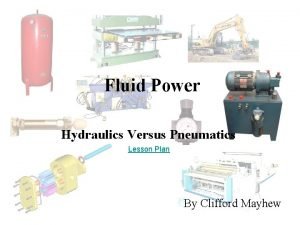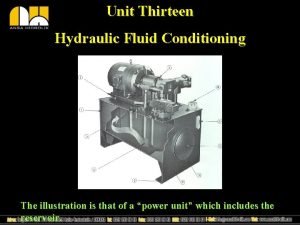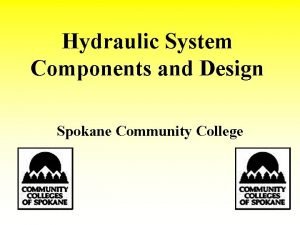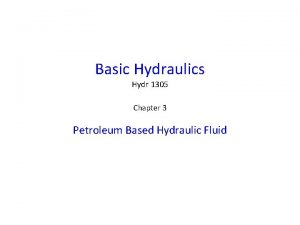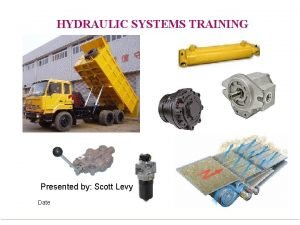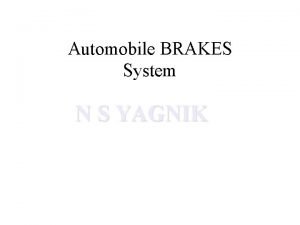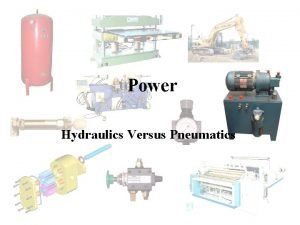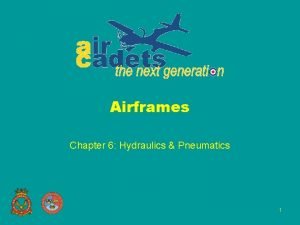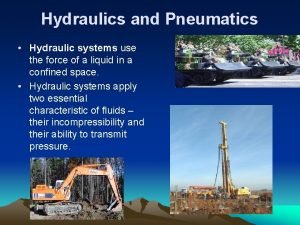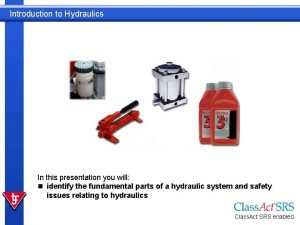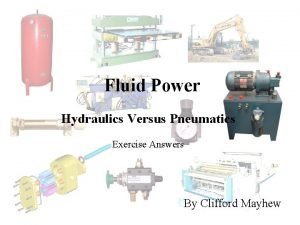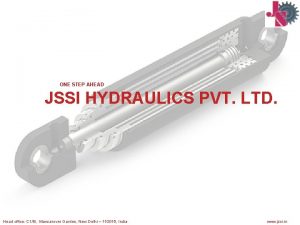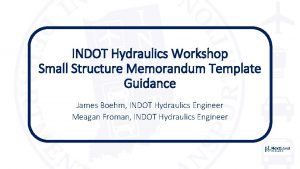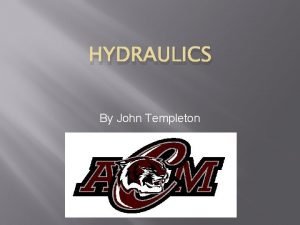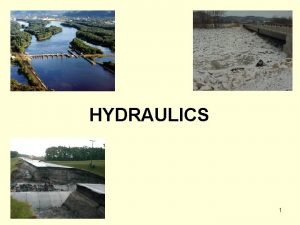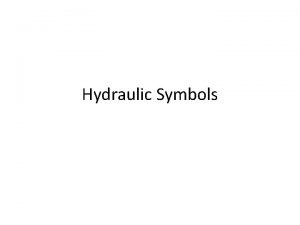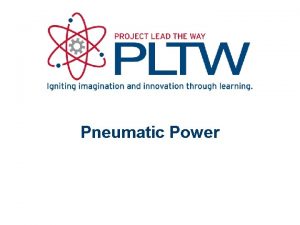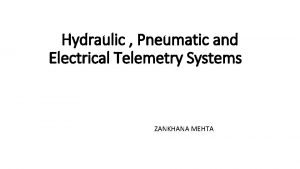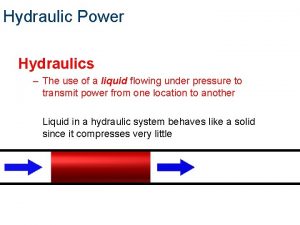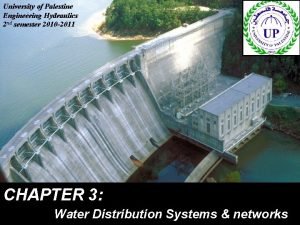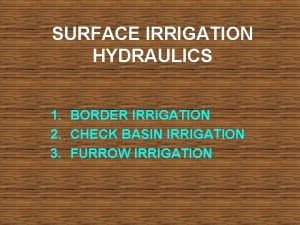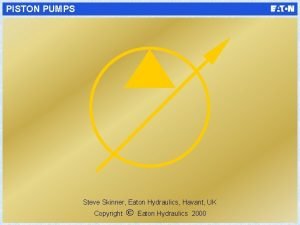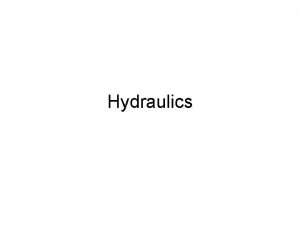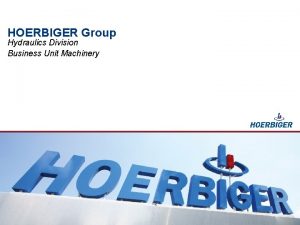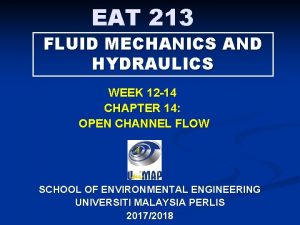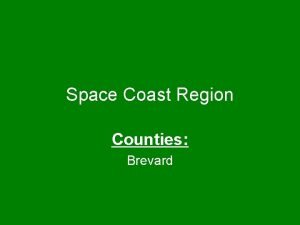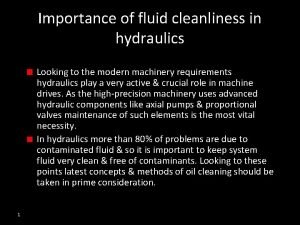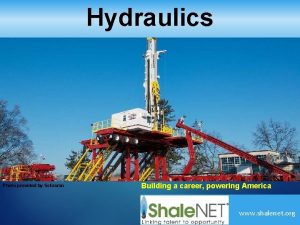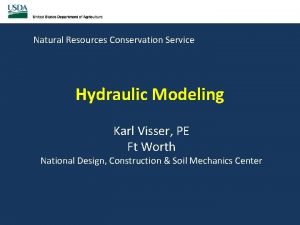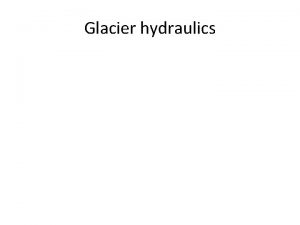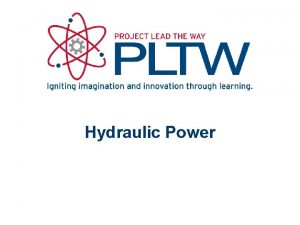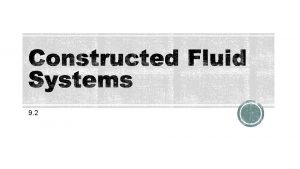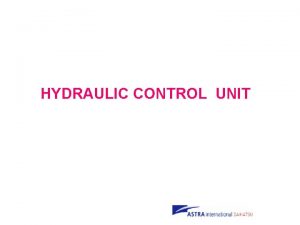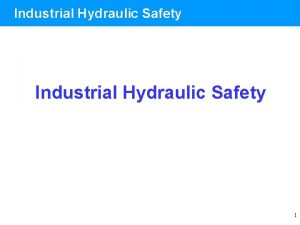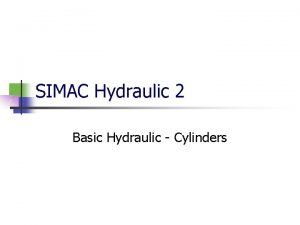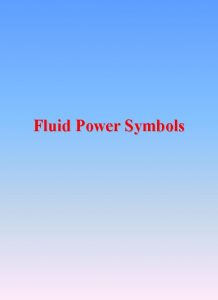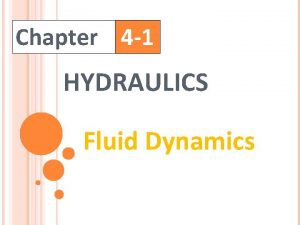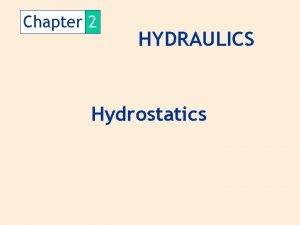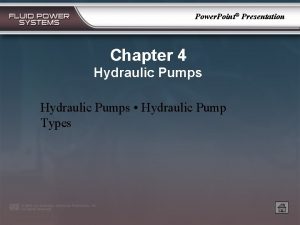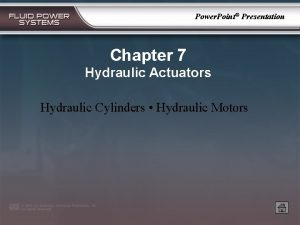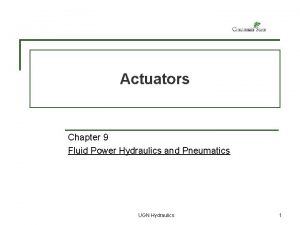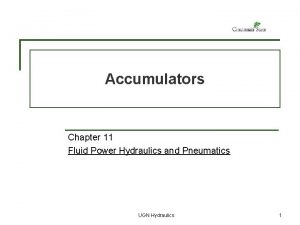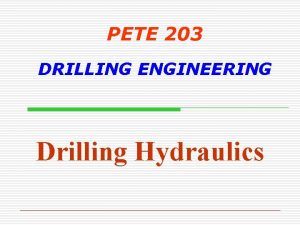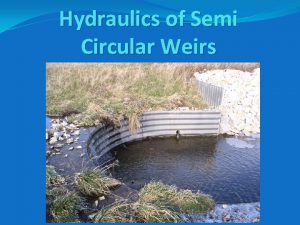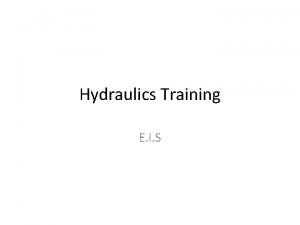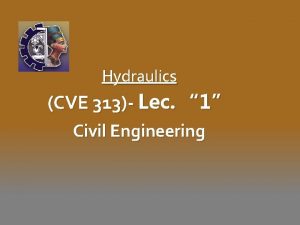Hydraulic Fluid Chapter 6 Fluid Power Hydraulics and































- Slides: 31

Hydraulic Fluid Chapter 6 Fluid Power Hydraulics and Pneumatics UGN Hydraulics 1

Learning Objectives n Describe the various functions a hydraulic fluid performs in a fluid power system. n Identify and explain the general properties of a liquid that would make it suitable as a hydraulic fluid. Name and describe the general categories of materials that are commonly used as hydraulic fluids. Explain the terms used to describe the basic characteristics of hydraulic fluids. Explain procedures to follow for the selection and performance monitoring of hydraulic fluids. Describe appropriate procedures for handling, storage, and disposal of hydraulic fluid. n n UGN Hydraulics smereka/Shuttersto ck. com 2

Functions of a Hydraulic Fluid n Transmits energy for work q n Flows easily and responds to pressure variations quickly Provides lubrication to reduce friction and minimize wear q q Protects from rust and corrosion Acts as basic system cleaner UGN Hydraulics 3

Performance Characteristics of a Hydraulic Fluid n Lubricating power q The fluid film separates surfaces of materials to reduce friction n q Fills irregularities in the bearing surfaces Lubricity is important to minimize wear of components UGN Hydraulics 4

Performance Characteristics of a Hydraulic Fluid n Resistance to flow q q q n Viscosity is the internal resistance to flow of a liquid High viscosity fluids resist flow Low viscosity fluids flow more easily Viscosity stability q Temperature and pressure changes affect fluid viscosity n q Viscosity index level Especially important with greater operating temperature range Goodheart-Willcox Publisher UGN Hydraulics 5

Performance Characteristics of a Hydraulic Fluid n Low-temperature-operating ability q Pour point is the ability of a fluid to flow when cold n The fluid should always be able to flow 20°F below lowest-expected ambient temperature Atlas Copco UGN Hydraulics 6

Performance Characteristics of a Hydraulic Fluid n Resistance to oxidation q q q Oxidation is a chemical reaction that increases oxygen content The Ideal fluid temperature in a reservoir 110– 140°F You need to minimize material contact that promotes oxidation Goodheart-Willcox Publisher UGN Hydraulics 7

Performance Characteristics of a Hydraulic Fluid n Reaction to condensation and water q n Water in the fluid will cause operational and service problems q q n Moisture in the atmosphere can condense and mix with the fluid Select petroleum-based fluids that resist water emulsion Additional water modifies water-based fluids Resistance to foaming q q Fluid foaming and air entrainment cause a variety of problems Foaming n n n q increases oxidation causes fluid loss slow operation due to compression of air within the fluid Sludge reduces performance and service life UGN Hydraulics 8

Performance Characteristics of a Hydraulic Fluid n Resistance to Fire q q q The flash point is the lowest temperature that a liquid gives off enough vapors to ignite with flame At the fire point temperature, a substance vaporizes rapidly to ignite and burn with flame The spontaneous ignition temperature is where the fluid ignites and burns without flame UGN Hydraulics 9

Commonly Used Hydraulic Fluids n Petroleum-based fluids q q n Most common type of hydraulic fluid Fluid blend of petroleum oils and additives Produces properties that allow the fluid to perform satisfactorily Withstands oxidation, resists foaming, separates from contaminants Biodegradable fluids q q q Environmentally safe fluids Vegetable or synthetic ester-based oils Large spills should be treated like petroleum-based fluids UGN Hydraulics 10

Commonly Used Hydraulic Fluids n Soluble-Oil Emulsions q q q n Systems with huge component parts use water mixed with 1– 5% soluble oil Functions well with pumps at pressures 2, 000– 3, 000 psi Must avoid freezing temperatures and must not exceed 140°F High-Water-Content Fluids q q q Primarily water with 2– 5% soluble chemicals Pumping capabilities up to 1, 000 psi Must avoid freezing temperatures and must not exceed 140°F Brand X UGN Hydraulics 11

Commonly Used Hydraulic Fluids n Fire-Resistant Fluids q q q Water-in-oil emulsions contain 40% water in an oil base Water-glycol fluids 35– 50% water, remainder polyglycol Synthetic fluids refined products containing additives that produce high levels of certain desired factors Goodheart-Willcox Publisher UGN Hydraulics 12

Hydraulic Fluid Additives n n Extreme-pressure agents prevent metal-to-metal contact and wear Anti-wear agents prevent metal-to-metal wear at lower operating pressures and temperatures Oxidation inhibitors reduce tendency of fluids to oxidize Rust inhibitors neutralize acids or form film on metals for protection Goodheart-Willcox Publisher UGN Hydraulics 13

Hydraulic Fluid Specifications UGN Hydraulics 14

Hydraulic Fluid Specifications n Fluid selection is based on system or component manufacturer recommendations n Specifications match system requirements and characteristics of fluid q Group of terms, test procedures, and units of measure UGN Hydraulics 15

Viscosity n n Absolute viscosity is the force per unit of area required to move one molecular layer of substance over layer of material Kinematic viscosity is the most precise indicator of viscosity q q Test measures time required for fixed amount of fluid to flow under gravity through a capillary viscometer Final rating is determined by multiplying flow time by a calibration constant Goodheart-Willcox Publisher UGN Hydraulics 16

Viscosity n ISO viscosity grades q q n 20 grades, based on kinematic viscosity grades at 40°C Can vary plus or minus 10% of the stated viscosity SAE viscosity grades q q Grades range from low of 0 to high of 60 Based on kinematic viscosity grades at 100°C UGN Hydraulics 17

Viscosity n Saybolt universal viscosity q q Test measures time required for 60 m. L of fluid at a specified temperature to flow through a calibrated orifice Not supported by standardizing group but widely used Goodheart-Willcox Publisher UGN Hydraulics 18

Viscosity Index n Part of specifications for most hydraulic fluids n Indicator of the kinematic viscosity variation between 40°C and 100°C q n Higher the index number, lower the rate of viscosity change ASTM standard 2270 used to determine number UGN Hydraulics 19

Specific and API Gravity n Compares the weight of given volume of a substance and equal volume of distilled water q q n Specific gravity can be used with any material API system is used primarily for petroleum products Hydrometer measures the specific gravity of fluids Goodheart-Willcox Publisher UGN Hydraulics 20

Pour Point n Is the lowest temperature a sample of fluid moves during a specific cooling procedure q The pour point is 3°C above this temperature Goodheart-Willcox Publisher UGN Hydraulics 21

Flash and Fire Points n Flash point q n Fire point q n The fluid temperature needed to form a flammable mixture with air The fluid temperature needed to support combustion The test flame is applied in 2°C increments Goodheart-Willcox Publisher UGN Hydraulics 22

Rust Prevention n Rusting may occur if water mixes with hydraulic oil n Test to indicate the ability of fluid to aid in rust prevention q q Run for 24 hours or longer If no rust, fluid passes UGN Hydraulics 23

Corrosion and Oxidation n Traces of sulfur compounds can exist due to the crude oil refining process q Causes problems with metal system component parts n Standard tests exist to check effects of hydraulic fluid corrosion on metals n Standard tests exist to determine the effects of hydraulic fluid resistance to oxidation UGN Hydraulics 24

Demulsibility and Foaming Characteristics n Demulsibility q n Foaming q n Ability of hydraulic fluid to separate from water Ability of hydraulic fluid to resist foam formation Determined by test procedures detailed in ASTM specifications UGN Hydraulics 25

Lubricity and Wear-Prevention Characteristics n n Evaluated by various ASTM standards Lubricity q q n Tinken method uses lab equipment Four-Ball Method rotates steel ball under load against three stationary balls Pump wear prevention is measured by the metal weight loss of a standard pump Goodheart-Willcox Publisher UGN Hydraulics 26

Storage and Handling of Fluids n Improperly stored fluid can become contaminated q q n Fluid loss Decreased MTBF and MTTR Properly store drums to avoid contamination q q Dry, cool, clean place indoors, lay on side Use clean equipment for fluid transfer and replenishment Goodheart-Willcox Publisher UGN Hydraulics 27

System Cleanliness n n n Poorly designed or constructed systems allow dirt in the fluid despite good housekeeping The reservoir requires a well-fitting cover with gasket to seal all openings Cylinder piston rods q n Piston rod wiper rings or boots prevent dirt from entering Regular inspections are necessary Goodheart-Willcox Publisher UGN Hydraulics 28

Fluid Operating Temperature n System operating temperature is a major factor in the service life of fluids q n Normal operating temperature of reservoir fluid is between 110°F and 140°F If above the recommended level, examine: q q q Ambient temperature of area system is operating Clearance for air circulation around reservoir General cleanliness of unit UGN Hydraulics 29

Fluid Operating Temperature n Proper reservoir size is important q n n Fluid capacity should be two to three times the gallons per minute flow rate of pump Pump inlet and system return lines should be positioned as far apart as possible Physical shape of the tank must be considered Continental Hydraulics UGN Hydraulics 30

Maintaining Fluid Cleanliness and Operating Temperature n Fluids are always contaminated to some degree during operation q n Filtration devices promote cleanliness Specialized heat-exchange devices must be used when the fluid temperatures cannot be held within the recommended operating range UGN Hydraulics 31
 Fluid power hydraulics and pneumatics
Fluid power hydraulics and pneumatics Fluid conditioning unit
Fluid conditioning unit Mil-h-7644 color
Mil-h-7644 color Petroleum based hydraulic fluid
Petroleum based hydraulic fluid What is the pressure in the hydraulic fluid?
What is the pressure in the hydraulic fluid? What is the pressure in the hydraulic fluid?
What is the pressure in the hydraulic fluid? Hydraulics vs pneumatics
Hydraulics vs pneumatics Advantages of hydraulic system
Advantages of hydraulic system Introduction to hydraulics and pneumatics
Introduction to hydraulics and pneumatics Introduction to hydraulics and pneumatics
Introduction to hydraulics and pneumatics Fluid power terms crossword
Fluid power terms crossword Real power and reactive power
Real power and reactive power Intracellular fluid and extracellular fluid examples
Intracellular fluid and extracellular fluid examples Extracellular fluid and interstitial fluid
Extracellular fluid and interstitial fluid Jssi hydraulics
Jssi hydraulics Indot design memo
Indot design memo Hydraulics definition
Hydraulics definition Hydraulics definition
Hydraulics definition Pressure relief valve symbol
Pressure relief valve symbol Hydraulics & pneumatics
Hydraulics & pneumatics Mehta hydraulics
Mehta hydraulics Hydraulics
Hydraulics Palestine hydraulics
Palestine hydraulics Border irrigation
Border irrigation Eaton hydraulics uk
Eaton hydraulics uk Hydraulics
Hydraulics Hoerbiger hydraulic
Hoerbiger hydraulic Hydraulics
Hydraulics Space coast hydraulics
Space coast hydraulics Fluid cleanliness system
Fluid cleanliness system Professional hydraulics
Professional hydraulics Hydraulics karl lagerfeld
Hydraulics karl lagerfeld
